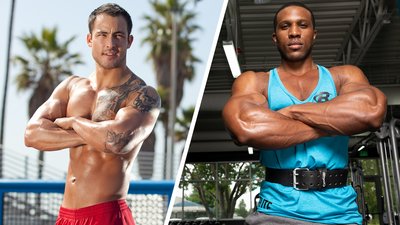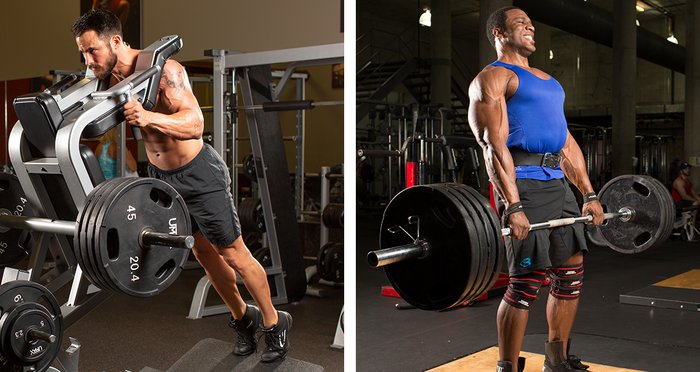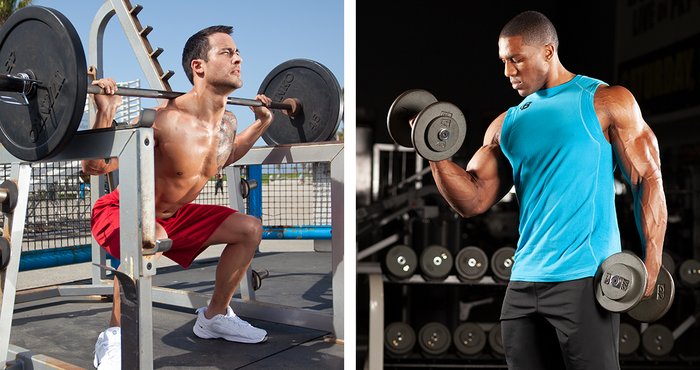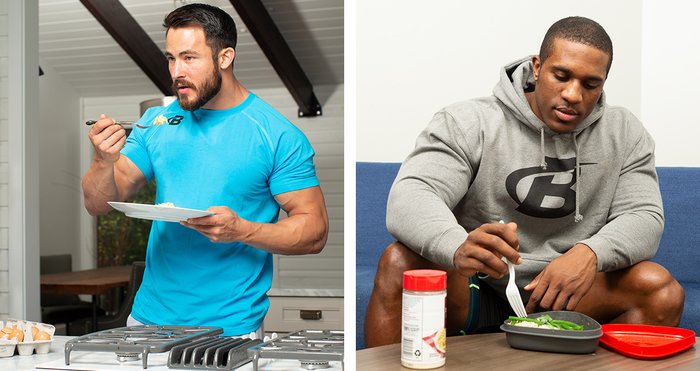[h=1]Beach Body or Bodybuilder? How Men Should Train and Eat for Each[/h]
Not all training is the same. Bodybuilders train with heavy weights to create a large, balanced physique. If you're after a beach body, you're looking for a leaner look, so you need to eat and lift a little less. But there's more to it than that.
<source media="(min-width: 600px)" srcset="https://www.bodybuilding.com/images/2018/august/beach-body-or-bodybuilder-how-men-should-train-and-eat-for-each-header-830x467.jpg" style="box-sizing: border-box;"><source media="(min-width: 400px)" srcset="https://www.bodybuilding.com/images/2018/august/beach-body-or-bodybuilder-how-men-should-train-and-eat-for-each-header-600x338.jpg" style="box-sizing: border-box;">
 </picture>
</picture>
<main role="main" id="main" data-bb-zone2="body" style="box-sizing: border-box;">

Christian KingAugust 17, 2018 • 6 min read
We all have a vision in our heads of what we would ultimately like to look like. Maybe you want to have an athletic, streamlined look with nice abs and just enough muscle to turn heads at a Vegas pool party. Or…maybe you aspire to be massive, with slabs of thick, dense muscle. You want people to see you and say, "Holy sh*t!"
Whichever way you go, it's your body, and it's entirely up to you what size and shape you want it to take. Once you've figured out which end of the spectrum you're interested in pursuing, the next step is to put together a training and nutrition program that suits those needs best. Here are some guidelines on how to train and eat to achieve either a beach body or a bodybuilder physique.
[h=2]Body-Part Focus[/h][h=3]Beach Body[/h]To build a standout beach body, focus on the same areas that men's physique competitors do: shoulders, upper back, chest, arms, and abs. You need to train your legs, of course, but if you're going to be wearing board shorts, there's no reason to strive for tree-trunk thighs.
Two areas deserving special attention are your abs and calves. Abs are always a focal point, so be sure to work them hard three times a week. Your thighs may be covered up most of the time, but your calves are always on display. Hit them at least twice a week for a total of 8-10 sets per session.
[h=3]Bodybuilder[/h]The mark of a bodybuilder is more than just his larger overall size. It's the balanced, complete look of his physique. To get there, you have to train all your muscle groups hard, but in proportion to each other. You don't want one group to either overpower or lag behind others.
This may mean backing off on areas that grow easier, while focusing on your more stubborn muscle groups by working them with extra intensity and frequency. You should develop your back, chest, shoulders, arms, quads, hams, and calves to their maximum potential.
[h=2]Repetition Range[/h][h=3]Beach Body[/h]Since you're not after bulk, you won't need to train with particularly heavy weights. Instead, keep the resistance and reps more moderate. Aim for sets of 12-15 reps for upper-body exercises and 12-20 for lower-body exercises.
 [h=3]Bodybuilder[/h]Stimulating as much hypertrophy as possible requires a mix of rep ranges. In the earlier stages of your training, when you're building a foundation, keep your reps a bit lower so you're building strength as well as size. That translates to 6-10 reps for the upper body and 8-12 for the lower.
[h=3]Bodybuilder[/h]Stimulating as much hypertrophy as possible requires a mix of rep ranges. In the earlier stages of your training, when you're building a foundation, keep your reps a bit lower so you're building strength as well as size. That translates to 6-10 reps for the upper body and 8-12 for the lower.
Having built some decent mass, start varying your rep ranges. You'll still be doing heavier sets, but now you'll be complementing them with higher-rep sets. A back workout might contain some sets in the 6-10 rep range, and others in the 12-15 range. You might even do supersets and dropsets for as many as 20-30 reps.
[h=2]Exercise Selection[/h][h=3]Beach Body[/h]Compound movements are excellent no matter your goal because they allow you to work several muscle groups at once. Just because you're not trying to be 250 pounds ripped doesn't mean you should avoid these big movements—the squats, deadlifts, bench presses, barbell rows, and military presses. Include those, but also perform movements that target the areas you're trying to build up.
If you want wider delts, do lateral raises with dumbbells, machines, or cables. Wider upper backs need chin-ups and lat pull-downs. Abs should be hit with plenty of crunches and leg raises. Calves will grow in response to standing and seated raises. Work those incline presses to put more mass on your upper chest, which adds to your overall look.
[h=3]Bodybuilder[/h]Bodybuilders need a mix of compound and isolation movements to develop each muscle group completely. To build out your shoulders, your basic compound movements would include overhead presses with a barbell or dumbbells. Follow that with lateral raises and bent-over rear lateral raises, or use a rear delt machine to target the side and rear heads of the deltoids.
 Back development happens with deadlifts plus rows and pull-downs from various angles. The chest should be trained with both flat and incline presses, as well as flyes. Legs require a higher volume to respond, so you should hit these with squats, leg presses, hack squats, leg extensions, leg curls (lying, seated, and standing), lunges, and Romanian deadlifts. (Not all in the same workout, of course!) Biceps grow from various types of curls, while the triceps need both isolated extension movements such as skullcrushers or cable push-downs, and compound exercises including close-grip bench presses and dips.
Back development happens with deadlifts plus rows and pull-downs from various angles. The chest should be trained with both flat and incline presses, as well as flyes. Legs require a higher volume to respond, so you should hit these with squats, leg presses, hack squats, leg extensions, leg curls (lying, seated, and standing), lunges, and Romanian deadlifts. (Not all in the same workout, of course!) Biceps grow from various types of curls, while the triceps need both isolated extension movements such as skullcrushers or cable push-downs, and compound exercises including close-grip bench presses and dips.
[h=2]Training Split[/h][h=3]Beach Body[/h]Training splits are always up to individual preferences, but it makes sense to combine related muscle groups. For instance, you could train "pull" muscles like chest, shoulders, and triceps one day; "push" muscles like back and biceps another day; and lower body and abs on a third day. Those could be done consecutively or with a rest day or two in between.
Since being lean is a priority when you want to properly showcase your beach body, include cardio at least three times a week—unless you're one of the lucky few who are naturally lean. If getting and staying lean is more of a challenge for you, you may have to do cardio as often as six times a week. You could train more like a bodybuilder and focus on just one muscle group a day, but it wouldn't make much sense given your different goals.
[h=3]Bodybuilder[/h]While bodybuilders certainly can combine muscle groups, most see better results when they dedicate separate training days to back, shoulders, chest, arms, and legs. Again, there are no hard rules here. If you want to train arms with chest or shoulders, go for it.
Similarly, you may feel your legs don't get the best gains unless you split up quads and hamstrings into their own workouts. You'll be assaulting your muscles with a huge variety of exercises. If you need to limit your weight-training sessions, combine just a couple of muscle groups, or cut back on the volume of each session. Few people can sustain maximum intensity in the gym for more than an hour anyway, so strive to complete your weight training in a reasonable amount of time.
[h=2]Meal Frequency[/h][h=3]Beach Body[/h]Aim for 3-4 solid meals, plus a protein shake or two, every day. Never go more than 3-4 hours without eating.
[h=3]Bodybuilder[/h]If you want to build extraordinary muscle mass, you must eat far more frequently than the average person. Plan on eating a bare minimum of four solid meals a day plus a shake, though you'll probably do better with five or even six meals. This translates to eating a meal every 2-3 waking hours. It's this ramped-up meal frequency that most would-be bodybuilders struggle with. It's not easy to prepare—and to eat—this much food every day, but it's what all the best bodybuilders do.
[h=2]Macros[/h][h=3]Beach Body[/h]You want to build muscle, but you also want to be lean. You should have protein, carbs, and healthy fats in your diet, but consume them all in moderation. Aim for a macro ratio of 40-percent protein, 30-percent carbohydrates, and 30-percent fat.
[h=3]Bodybuilder[/h]The bodybuilder macronutrient ratio should be more like 45-percent protein, 45-percent carbohydrates, and 10-percent fat. For maximum muscle gains, you need a lot of both protein and carbohydrates, and a certain amount of fat to support various body functions. If you have a tough time gaining weight, shift your macros to 35-percent protein, 55-percent carbohydrates, and 10-percent fat.
 [h=2]Portion Sizes[/h][h=3]Beach Body[/h]Portion sizes will always vary depending on your size, metabolic rate, and activity level. Nevertheless, it's safe to say that anyone looking to own a killer beach body shouldn't be stuffing himself with excess calories. A typical meal for a 180-pound man looking to stay lean or maybe build a little muscle—while losing fat—should be about 8 ounces of chicken and a cup of cooked rice. Keep a food diary for at least the first few weeks to see just how much food you need. Find your path between going overboard and gaining fat versus under-eating and losing muscle mass.
[h=2]Portion Sizes[/h][h=3]Beach Body[/h]Portion sizes will always vary depending on your size, metabolic rate, and activity level. Nevertheless, it's safe to say that anyone looking to own a killer beach body shouldn't be stuffing himself with excess calories. A typical meal for a 180-pound man looking to stay lean or maybe build a little muscle—while losing fat—should be about 8 ounces of chicken and a cup of cooked rice. Keep a food diary for at least the first few weeks to see just how much food you need. Find your path between going overboard and gaining fat versus under-eating and losing muscle mass.
[h=3]Bodybuilder[/h]Portion sizes would be very different for a 180-pound journeyman bodybuilder than for a 350-pound pro, but the concept remains the same. In general, you want to consume a surplus of protein, carbohydrates, healthy fats, and calories to support heavy training, muscle recovery, and growth. That might mean eating a meal of 12 ounces of chicken or steak, along with 2 cups of cooked rice or a large sweet potato.
Many bodybuilders I've known will have breakfasts of 2-3 whole eggs, 6-8 egg whites, a cup of oatmeal or cream of wheat (dry measure) with berries, and two slices of wheat toast. Portion sizes will obviously change when a bodybuilder is bulking versus cutting. When you're cutting, you usually keep your protein portions consistent while lowering your carbs.
[h=2]Supplements[/h]The same supplements can and should be used by beach bodies and bodybuilders alike to successfully reach their goals. Here's a short list:
</main>
Not all training is the same. Bodybuilders train with heavy weights to create a large, balanced physique. If you're after a beach body, you're looking for a leaner look, so you need to eat and lift a little less. But there's more to it than that.
<source media="(min-width: 600px)" srcset="https://www.bodybuilding.com/images/2018/august/beach-body-or-bodybuilder-how-men-should-train-and-eat-for-each-header-830x467.jpg" style="box-sizing: border-box;"><source media="(min-width: 400px)" srcset="https://www.bodybuilding.com/images/2018/august/beach-body-or-bodybuilder-how-men-should-train-and-eat-for-each-header-600x338.jpg" style="box-sizing: border-box;">

<main role="main" id="main" data-bb-zone2="body" style="box-sizing: border-box;">

Christian KingAugust 17, 2018 • 6 min read
We all have a vision in our heads of what we would ultimately like to look like. Maybe you want to have an athletic, streamlined look with nice abs and just enough muscle to turn heads at a Vegas pool party. Or…maybe you aspire to be massive, with slabs of thick, dense muscle. You want people to see you and say, "Holy sh*t!"
Whichever way you go, it's your body, and it's entirely up to you what size and shape you want it to take. Once you've figured out which end of the spectrum you're interested in pursuing, the next step is to put together a training and nutrition program that suits those needs best. Here are some guidelines on how to train and eat to achieve either a beach body or a bodybuilder physique.
[h=2]Body-Part Focus[/h][h=3]Beach Body[/h]To build a standout beach body, focus on the same areas that men's physique competitors do: shoulders, upper back, chest, arms, and abs. You need to train your legs, of course, but if you're going to be wearing board shorts, there's no reason to strive for tree-trunk thighs.
Two areas deserving special attention are your abs and calves. Abs are always a focal point, so be sure to work them hard three times a week. Your thighs may be covered up most of the time, but your calves are always on display. Hit them at least twice a week for a total of 8-10 sets per session.
[h=3]Bodybuilder[/h]The mark of a bodybuilder is more than just his larger overall size. It's the balanced, complete look of his physique. To get there, you have to train all your muscle groups hard, but in proportion to each other. You don't want one group to either overpower or lag behind others.
This may mean backing off on areas that grow easier, while focusing on your more stubborn muscle groups by working them with extra intensity and frequency. You should develop your back, chest, shoulders, arms, quads, hams, and calves to their maximum potential.
[h=2]Repetition Range[/h][h=3]Beach Body[/h]Since you're not after bulk, you won't need to train with particularly heavy weights. Instead, keep the resistance and reps more moderate. Aim for sets of 12-15 reps for upper-body exercises and 12-20 for lower-body exercises.

Having built some decent mass, start varying your rep ranges. You'll still be doing heavier sets, but now you'll be complementing them with higher-rep sets. A back workout might contain some sets in the 6-10 rep range, and others in the 12-15 range. You might even do supersets and dropsets for as many as 20-30 reps.
[h=2]Exercise Selection[/h][h=3]Beach Body[/h]Compound movements are excellent no matter your goal because they allow you to work several muscle groups at once. Just because you're not trying to be 250 pounds ripped doesn't mean you should avoid these big movements—the squats, deadlifts, bench presses, barbell rows, and military presses. Include those, but also perform movements that target the areas you're trying to build up.
If you want wider delts, do lateral raises with dumbbells, machines, or cables. Wider upper backs need chin-ups and lat pull-downs. Abs should be hit with plenty of crunches and leg raises. Calves will grow in response to standing and seated raises. Work those incline presses to put more mass on your upper chest, which adds to your overall look.
[h=3]Bodybuilder[/h]Bodybuilders need a mix of compound and isolation movements to develop each muscle group completely. To build out your shoulders, your basic compound movements would include overhead presses with a barbell or dumbbells. Follow that with lateral raises and bent-over rear lateral raises, or use a rear delt machine to target the side and rear heads of the deltoids.

[h=2]Training Split[/h][h=3]Beach Body[/h]Training splits are always up to individual preferences, but it makes sense to combine related muscle groups. For instance, you could train "pull" muscles like chest, shoulders, and triceps one day; "push" muscles like back and biceps another day; and lower body and abs on a third day. Those could be done consecutively or with a rest day or two in between.
Since being lean is a priority when you want to properly showcase your beach body, include cardio at least three times a week—unless you're one of the lucky few who are naturally lean. If getting and staying lean is more of a challenge for you, you may have to do cardio as often as six times a week. You could train more like a bodybuilder and focus on just one muscle group a day, but it wouldn't make much sense given your different goals.
[h=3]Bodybuilder[/h]While bodybuilders certainly can combine muscle groups, most see better results when they dedicate separate training days to back, shoulders, chest, arms, and legs. Again, there are no hard rules here. If you want to train arms with chest or shoulders, go for it.
Similarly, you may feel your legs don't get the best gains unless you split up quads and hamstrings into their own workouts. You'll be assaulting your muscles with a huge variety of exercises. If you need to limit your weight-training sessions, combine just a couple of muscle groups, or cut back on the volume of each session. Few people can sustain maximum intensity in the gym for more than an hour anyway, so strive to complete your weight training in a reasonable amount of time.
[h=2]Meal Frequency[/h][h=3]Beach Body[/h]Aim for 3-4 solid meals, plus a protein shake or two, every day. Never go more than 3-4 hours without eating.
[h=3]Bodybuilder[/h]If you want to build extraordinary muscle mass, you must eat far more frequently than the average person. Plan on eating a bare minimum of four solid meals a day plus a shake, though you'll probably do better with five or even six meals. This translates to eating a meal every 2-3 waking hours. It's this ramped-up meal frequency that most would-be bodybuilders struggle with. It's not easy to prepare—and to eat—this much food every day, but it's what all the best bodybuilders do.
[h=2]Macros[/h][h=3]Beach Body[/h]You want to build muscle, but you also want to be lean. You should have protein, carbs, and healthy fats in your diet, but consume them all in moderation. Aim for a macro ratio of 40-percent protein, 30-percent carbohydrates, and 30-percent fat.
[h=3]Bodybuilder[/h]The bodybuilder macronutrient ratio should be more like 45-percent protein, 45-percent carbohydrates, and 10-percent fat. For maximum muscle gains, you need a lot of both protein and carbohydrates, and a certain amount of fat to support various body functions. If you have a tough time gaining weight, shift your macros to 35-percent protein, 55-percent carbohydrates, and 10-percent fat.

[h=3]Bodybuilder[/h]Portion sizes would be very different for a 180-pound journeyman bodybuilder than for a 350-pound pro, but the concept remains the same. In general, you want to consume a surplus of protein, carbohydrates, healthy fats, and calories to support heavy training, muscle recovery, and growth. That might mean eating a meal of 12 ounces of chicken or steak, along with 2 cups of cooked rice or a large sweet potato.
Many bodybuilders I've known will have breakfasts of 2-3 whole eggs, 6-8 egg whites, a cup of oatmeal or cream of wheat (dry measure) with berries, and two slices of wheat toast. Portion sizes will obviously change when a bodybuilder is bulking versus cutting. When you're cutting, you usually keep your protein portions consistent while lowering your carbs.
[h=2]Supplements[/h]The same supplements can and should be used by beach bodies and bodybuilders alike to successfully reach their goals. Here's a short list:
- Protein powder (whey isolate and a whey/casein blend)
- Multivitamin/mineral
- Creatine monohydrate
- Pre-workout formula
- L-glutamine
- BCAAs
</main>




